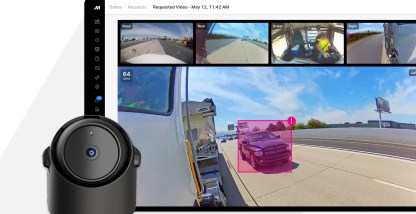Now that traditional, schedule-centric maintenance methods are becoming obsolete, fleet managers whose priorities have shifted more toward modernizing and improving fleet maintenance measures are becoming more interested in predictive maintenance.
This article will thoroughly define predictive maintenance, address its many benefits, describe how it differs from preventive maintenance, and more.
What is predictive maintenance?
Predictive maintenance (PdM) is a proactive upkeep strategy that tracks vehicle and asset health and uses data science and analytics to forecast when vehicles and assets will need maintenance so they can be addressed before breakdowns occur.
Also known as condition-based maintenance, predictive maintenance aims to boost the efficiency of a fleet and minimize downtimes and operational expenses over time.
It uses sophisticated data analysis tools to detect warning signs of potential vehicle failures, so PdM requires detailed preparation in order to operate accurately. PdM tools uncover defects, identify potential malfunctions, and other issues that could negatively impact fleet health and disrupt operations.
PdM tools rely on a combination of sensory devices, the Internet of Things (IoT), machine learning (ML), and data models and analytics, among others, to assess a vehicle’s condition. Below is an overview of how each tool or method contributes to the predictive maintenance process.
- Sensors or condition-monitoring devices. Sensors gather information related to the health and performance of your fleet. Depending on the tools used, you can obtain crucial details, such as vibration, temperature, pressure, and noise.
- Internet of Things. IoT converts the collected information into electronic signals that can be quantified and studied over time to forecast when the vehicle or asset will require maintenance.
- Machine learning. Machine learning technology uses collected data to analyze the behavior of a vehicle. Specifically, it lets you define health conditions and quality control metrics for every vehicle and asset component based on historical information. When it has sufficient data, it can quickly identify any anomalies in the performance of the vehicle or asset and make predictions regarding the overall health of the fleet and when operational disruptions may occur.
- Computerized maintenance management system (CMMS). This solution automatically creates work orders for technicians when anomalies happen. CMMS helps optimize and streamline vehicle maintenance work because technicians are prompted to conduct maintenance even without manual requests.
- Flexible cloud architecture. This functionality allows the seamless integration of third-party apps for additional contextual information. Cloud computing capabilities make big data processing possible and give access to valuable data from any location or device.
What is the difference between preventive and predictive maintenance?
While preventive and predictive maintenance are both proactive vehicle upkeep strategies to help reduce vehicle breakdowns, they vary in specific ways.
For instance, preventive maintenance is scheduled periodically or at regular intervals whether or not the vehicles need it. Although intended to keep vehicles in their best shape, the preventive maintenance method doesn’t consider the current condition of the fleet.
Predictive maintenance is done according to the condition of the fleet and, therefore, when vehicles actually require upkeep or maintenance activities.
Preventive maintenance follows a calendar schedule and relies more on human observation. Its activities are prompted primarily by time-sensitive triggers (yearly, monthly, weekly, etc.) or vehicle usage (e.g., an inspection every 5,000 miles traveled).
Predictive maintenance depends heavily on live fleet performance analytics, including personnel observations along with other automated tools, to recognize or predict issues in their early stages. Predictive maintenance is prompted by data-based warnings to determine the vehicles’ upkeep needs and schedules.
The primary difference between preventive and predictive maintenance is that preventive maintenance requires more human intervention (with manual or electronic tools assisting technicians), while predictive maintenance minimizes manual interaction by automating most of the tasks with the help of modern technologies.
Benefits of a predictive maintenance strategy
Your fleet can benefit in countless ways when you have an effective predictive maintenance program in place. The following are some of the many benefits of a predictive maintenance strategy.
Reduced risk
Predictive maintenance tools gather and analyze relevant information from individual vehicle profiles and vehicle maintenance history, and because you’re getting accurate vehicle health information, you minimize guesswork when inspecting errors and oversight.
You can get relatively reliable estimates of risks involved because the predictive maintenance software uses quantifiable data, powerful analysis techniques, and precise calculations.
From there, it recommends the next best steps and upkeep schedules to implement. With this, you’re in a better position to decrease the likelihood of mechanical failures and accidents.
Reduced downtimes
Predictive maintenance programs significantly lessen vehicle downtime. By accurately identifying potential vehicle issues, you can avoid out-of-the-blue mechanical failures and reactive maintenance activities that disrupt operations.
As you only schedule maintenance work when specific conditions are met and diagnostics are needed, you minimize premature upkeep and vehicle downtime. You also avoid replacing parts that are still usable and functional. All these boost fleet efficiencies, keep costs in line, and improve the operational availability of your vehicles.
Extended vehicle and asset life cycles
Through intelligent monitoring and data-supported upkeep suggestions, vehicles and assets are fixed before any predictable severe damages occur. This prevents needless downtimes or long, unforeseen repairs.
As a result, you lessen their wear and tear, and vehicles can remain in their optimal conditions for a longer time, sometimes even beyond their average lifespans.
Reduced operational expenditures
Predictive maintenance programs help you optimize and intelligently plan how you allocate your resources and fleet-related expenditures, which can help to minimize maintenance expenses.
Effective PdM maintenance means you’re spending money on vehicle maintenance only when it’s necessary. It may also prevent costly repairs from occurring and reduce service expenses by focusing on specific vehicle maintenance tasks as needed.
You can precisely allocate your funds for inspections, parts replacement, and repairs verified to be necessary. By removing the guesswork, plus enhancing maintenance forecasts, you avoid wasting money.
Contribution to a cleaner environment
Well-maintained vehicles can perform optimally, enhance fuel economy, and reduce your carbon footprint on the planet.
Through predictive maintenance, you can detect issues in advance (or while they’re still minor) that can hurt your gas mileage. These include a clogged air filter, oxygen sensors with signs of defect, low tire pressure, etc.
If you don’t foresee and fix these issues, you can spend more fuel as you continue your driving operations and produce more carbon emissions. With predictive maintenance, you change oil only when you need to, reducing gasoline wastage.
Features to look for in predictive maintenance tools and software
When choosing predictive maintenance tools for your fleet, consider these features:
Risk identification
The predictive maintenance software you choose must be able to detect critical events and provide actionable insights into those areas that need attention.
It should have the capability to capture vast quantities of engine and system performance data, record external surroundings and driver behavior, along with storing vehicle usage metrics and other risk-related variables.
Asset tracking
Reliable predictive maintenance tools should improve visibility into fleet performance and monitor each vehicle or asset’s status for potential defects and damages. The more robust PdM tools can trace failure statuses and recognize related patterns over time, enabling you to identify and target precisely which vehicles or components need timely upkeep and to meet those requirements.
Data management
Another must-have feature of predictive maintenance tools is organized data collection and management.
The software should be able to gather all relevant information, define specific tracking metrics, and measure the data’s impact on your fleet’s maintenance requirements.
Your predictive maintenance software must also have user-intuitive dashboards and features to present data in an easy-to-understand format.
It should provide easy-to-understand visual and narrative reports, including summaries. The interface and navigation systems should be straightforward, allowing you to access the information you need easily and quickly.
Additionally, the predictive maintenance software should also have the capability to synchronize all data from different departments and devices.
With these features, you can quickly obtain and organize your data any way you need. This helps you make well-informed vehicle maintenance strategies and associated business decisions.
Maintenance reminders
Predictive maintenance already uses sophisticated technologies to determine and forecast your fleet’s upkeep needs. A reliable predictive maintenance software must also provide automatic vehicle maintenance reminders.
The function notifies you of approaching recommended and calendared maintenance activities based on pre-set monitoring metrics, machine-analyzed needs, and synced service records.
Customizable DVIRs
You should also consider a predictive maintenance tool that has built-in customizable electronic driver vehicle inspection reports (DVIRs).
This functionality simplifies inspection, maintenance, and reporting systems for fleet managers, drivers, technicians, and other concerned personnel.
It also allows drivers to complete their DVIRs by choosing from the pre-populated options, adding comments, uploading photos, and instantly submitting reports.
Predictive maintenance tools with rich DVIR customization features align the reporting system with your company-specific operations, vehicle and asset inspection processes, and other critical factors.
Why Motive should be your predictive maintenance solution
Motive’s proactive maintenance solution helps you easily stay on top of managing vehicle and asset health so you can keep your fleet on the road.
Motive automatically tracks service needs and notifies you with maintenance reminders to help you stay on top of scheduling. With customizable DVIRs, fleets can stay compliant and define their own processes that fit their specific needs.
When dealing with the unexpected, vehicle diagnostic fault codes are detected automatically, and fleet managers receive instant fault-code notifications with relevant data and actionable insights when these occur. Repeat fault codes are also flagged and highlighted in historical reports, making it easier to predict and address potential vehicle issues quickly.
Fleet managers also get access to detailed vehicle utilization reports to spot irregular fuel consumption that can warn you of potential vehicle issues.
Motive’s maintenance solution provides advanced reporting to help you analyze vehicle and asset maintenance trends, plus inspection history reports to simplify and streamline vehicle fleet management.
Increase vehicle uptime, reduce repair costs, improve safety, and extend the life of your vehicles and assets with Motive’s proactive maintenance solution.
Request a free demo today to learn more about the Motive fleet management solution and how it can simplify how you manage vehicle and asset maintenance.









